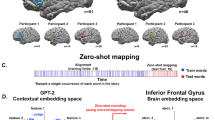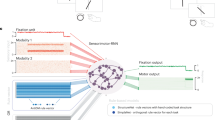Abstract
Despite the numerous examples of anticipatory cognitive processes at micro and macro levels in many animal species, the idea that anticipation of specific words plays an integral role in real-time language processing has been contentious. Here we exploited a phonological regularity of English indefinite articles ('an' precedes nouns beginning with vowel sounds, whereas 'a' precedes nouns beginning with consonant sounds) in combination with event-related brain potential recordings from the human scalp to show that readers' brains can pre-activate individual words in a graded fashion to a degree that can be estimated from the probability that each word is given as a continuation for a sentence fragment offline. These findings are evidence that readers use the words in a sentence (as cues to their world knowledge) to estimate relative likelihoods for upcoming words.
This is a preview of subscription content, access via your institution
Access options
Subscribe to this journal
Receive 12 print issues and online access
$209.00 per year
only $17.42 per issue
Buy this article
- Purchase on Springer Link
- Instant access to full article PDF
Prices may be subject to local taxes which are calculated during checkout

Similar content being viewed by others
References
Stanovich, K.E. & West, R.F. Mechanisms of sentence context effects in reading: automatic activation and conscious attention. Mem. Cognit. 7, 77–85 (1979).
Kintsch, W. & van Dijk, T.A. Towards a model of text comprehension and production. Psychol. Rev. 85, 363–394 (1978).
Carroll, J. & Bever, T. Sentence comprehension: a case study in the relation of knowledge and perception. in Handbook of Perception, Vol. 7 (eds. Carterette, E. & Friedman, M.) 299–317 (Academic, New York, 1978).
Just, M.A. & Carpenter, P.A. A theory of reading: From eye fixations to comprehension. Psychol. Rev. 87, 329–354 (1980).
Daneman, M. & Carpenter, P.A. Individual differences in integrating information between and within sentences. J. Exp. Psychol. Learn. Mem. Cogn. 9, 561–584 (1983).
Mitchell, D.C. & Green, D.W. The effects of context and content on immediate processing in reading. Q. J. Exp. Psychol. 30, 609–636 (1978).
Marslen-Wilson, W.D. Sentence perception as an interactive parallel process. Science 189, 226–228 (1975).
Altmann, G.T.M. & Steedman, M.J. Interaction with context during human sentence processing. Cognition 30, 191–238 (1988).
Pickering, M.J. Processing local and unbounded dependencies: a unified account. J. Psycholinguist. Res. 23, 323–352 (1994).
Tyler, L.K. & Marslen-Wilson, W.D. The on-line effects of semantic context on syntactic processing. J. Verb. Learn. Verb. Behav. 16, 683–692 (1977).
Traxler, M., Bybee, M. & Pickering, M. Influence of connectives on language comprehension: eye-tracking evidence for incremental interpretation. Q. J. Exp. Psychol. A 50A, 481–497 (1997).
Marslen-Wilson, W.D. & Tyler, L.K. The temporal structure of spoken language understanding. Cognition 8, 1–71 (1980).
Steedman, M. Grammar, interpretation, and processing from the lexicon. in Lexical Representation and Process (ed. Marslen-Wilson, W.D.) 463–504 (MIT Press, Cambridge, Massachusetts, 1989).
Boland, J.E., Tanenhaus, M.K., Garnsey, S.M. & Carlson, G.N. Verb argument structure in parsing and interpretation: Evidence from wh-questions. J. Mem. Lang. 34, 774–806 (1995).
Tanenhaus, M., Spivey-Knowlton, M., Eberhard, K. & Sedivy, J. Integration of visual and linguistic information during spoken language comprehension. Science 268, 1632–1634 (1995).
Kutas, M. & Hillyard, S.A. Event-related brain potentials to grammatical errors and semantic anomalies. Mem. Cognit. 11, 539–550 (1983).
Kutas, M. & Hillyard, S.A. Reading senseless sentences: brain potentials reflect semantic incongruity. Science 207, 203–204 (1980).
Kutas, M. & Hillyard, S.A. Brain potentials during reading reflect word expectancy and semantic association. Nature 307, 161–163 (1984).
Altmann, G.T.M. & Kamide, Y. Incremental interpretation at verbs: restricting the domain of subsequent reference. Cognition 73, 247–264 (1999).
Tanenhaus, M.K., Magnuson, J.S., Dahan, D. & Chambers, C. Eye movements and lexical access in spoken-language comprehension: evaluating a linking hypothesis between fixations and linguistic processing. J. Psycholinguist. Res. 29, 557–580 (2000).
Kamide, Y., Scheepers, C. & Altmann, G.T.M. Integration of syntactic and semantic information in predictive processing: cross-linguistic evidence from German and English. J. Psycholinguist. Res. 32, 37–55 (2003).
Chambers, C.G. & Smyth, R. Structural parallelism and discourse coherence: a test of centering theory. J. Mem. Lang. 39, 593–608 (1998).
Sedivy, J.C., Tanenhaus, M.K., Chambers, C.G. & Carlson, G.N. Achieving incremental semantic interpretation through contextual representation. Cognition 71, 109–148 (1999).
Federmeier, K.D. & Kutas, M. A rose by any other name: long-term memory structure and sentence processing. J. Mem. Lang. 41, 469–495 (1999).
Wicha, N.Y.Y., Moreno, E.M. & Kutas, M. Anticipating words and their gender: an event-related brain potential study of semantic integration, gender expectancy, and gender agreement in Spanish sentence reading. J. Cogn. Neurosci. 16, 1272–1288 (2004).
Wicha, N.Y.Y., Bates, E.A., Moreno, E.M. & Kutas, M. Potato not Pope: human brain potentials to gender expectation and agreement in Spanish spoken sentences. Neurosci. Lett. 346, 165–168 (2003).
Van Berkum, J.J.A., Brown, C.M., Zwitserlood, P., Kooijman, V. & Hagoort, P. Anticipating upcoming words in discourse: evidence from ERPs and reading times. J. Exp. Psychol. Learn. Mem. Cogn. 31, 443–467 (2005).
O'Regan, K. Saccade size control in reading: evidence for the linguistic control hypothesis. Percept. Psychophys. 25, 501–509 (1979).
Kutas, M. Event-related brain potentials (ERPs) elicited during rapid serial visual presentation of congruous and incongruous sentences. Electroencephalogr. Clin. Neurophysiol. 40 (suppl.), 406–411 (1987).
Gunter, T.C., Jackson, J.L. & Mulder, G. An electrophysiological study of semantic processing in young and middle-aged academics. Psychophysiology 29, 38–54 (1992).
King, J.W. & Kutas, M. A brain potential whose latency indexes the length and frequency of words. CRL Newsletter 10, 1–9 (1995).
Kluender, R. & Kutas, M. Subjacency as a processing phenomenon. Lang. Cognitive Proc. 8, 573–633 (1993).
Acknowledgements
Many thanks to E. De Ochoa and J. Cagle for help with data collection and to J. Elman for helpful comments on this manuscript. This research was supported by US National Institute of Child Health and Human Development grant HD22614 and National Institute on Aging grant AG08313 to M.K. and by a Center for Research in Language Training Fellowship to K.A.D.
Author information
Authors and Affiliations
Corresponding author
Ethics declarations
Competing interests
The authors declare no competing financial interests.
Supplementary information
Rights and permissions
About this article
Cite this article
DeLong, K., Urbach, T. & Kutas, M. Probabilistic word pre-activation during language comprehension inferred from electrical brain activity. Nat Neurosci 8, 1117–1121 (2005). https://doi.org/10.1038/nn1504
Received:
Accepted:
Published:
Issue Date:
DOI: https://doi.org/10.1038/nn1504
This article is cited by
-
Neural evidence of word prediction
Nature Reviews Psychology (2024)
-
The role of multimodal cues in second language comprehension
Scientific Reports (2023)
-
Semantic preview effect of relatedness and plausibility in reading Chinese: evidence from high constraint sentences
Reading and Writing (2023)
-
Category Mistakes Electrified
Review of Philosophy and Psychology (2023)
-
Semantic systems are mentalistically activated for and by social partners
Scientific Reports (2022)



